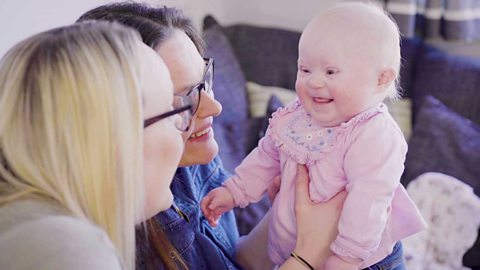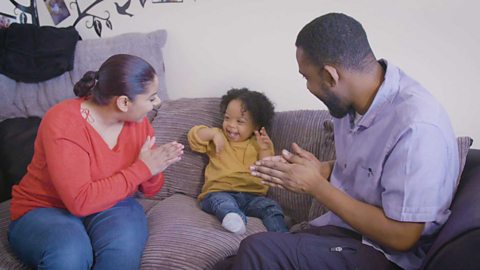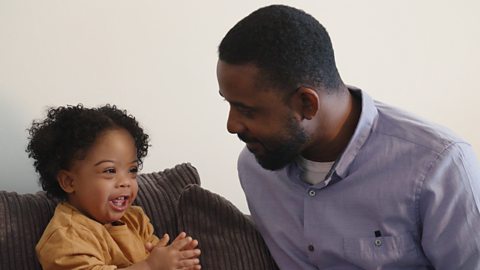Alys Mathers is a Highly Specialist Speech and Language Therapist and works with children who have a wide range of speech, language and communication needs.
Here she talks about the ways in which creative activities can help your child communicate.
As well as developing their creative streak and motor skills, art and craft activities are great for developing childrenâs communication skills when you join in, and chat to them as you make, draw or colour. They're also sociable: everyone can join in with getting creative at home â old or young, with or without special educational needs and no matter how artistic they (or you) are.
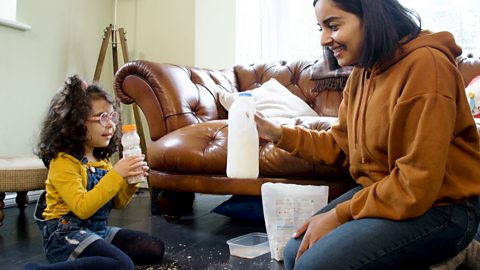
Children with special educational needs (including language and communication needs) will experience particular benefits from arty opportunities.
Their language learning will be helped by:
- Exploring textures
Children learn description words such as âsoftâ and âstickyâ by experiencing those sensations, and craft activities are ideal for encouraging children to get stuck in with touching and feeling new textures.
- Using actions
Action words, such as âstretchâ and âsprinkleâ, and abstract concepts, such as âinâ, âoutâ, âfullâ and âemptyâ are much easier to learn and remember during activities when your child can have a go themselves.
- Focusing their attention
Creative activities help stretch childrenâs attention spans, as they stay focused to reach the end goal of a finished picture or model. By sharing the activity with them, you are showing your child how to concentrate for longer and longer. The sense of achievement when they have finished shows them it was worth sticking with!
- Hearing words repeatedly
Arts and crafts let children hear and use the same words and sentences lots of times. This is important for language learning for all children, but particularly those with language and communication needs.
Let your child lead with their creativity
You may also notice that when youâre relaxed and focused on an activity together, itâs easier to let your child lead the activity and conversation. You may hear your child chatting more, and can watch their language skills develop by taking time to make something together. So get rid of any distractions you can, and look forward to sharing that sense of pride in the finished creation with your child.
Children will have even better ideas than us adults for how to play with paints, glue or clay. So if in doubt, let them lead the way, copying and commenting on what theyâre doing. That way, youâll always have fun.
But here are some activity suggestions to get you startedâŠ
Finger painting
Even the youngest children can get their hands stuck in with paint. Use words and sounds when you touch the paint like âgloopâ and âsquishâ to encourage them to play with both sounds and paint. Even cleaning up after finger painting is a good time to talk about parts of the body as you wipe the paint off them â hands, fingers, arms, nose⊠and anywhere else it might get to. To help your childâs understanding, talk about what youâre painting and use simple actions at the same time (for example, you might talk about âthe seaâ, while doing a wavy 'water' action with your hands), just like our finger-painting Tiny Happy People families.
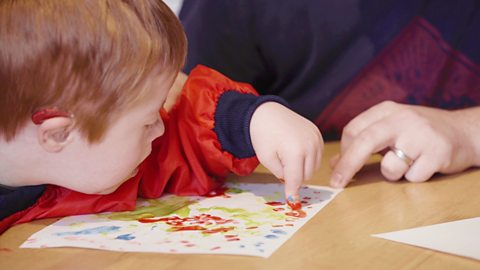
Music makers
Children learn language through music and songs, with the help of the rhythm, repetition and actions. And you donât need advanced crafting skills to make the perfect instrument. You can make a simple shaker or rainstick using everyday items from around the house.
When making the instrument, use words such as âinâ, âfullâ and âpourâ to describe what you are doing. Let your child join in, and give them time to say what they are doing â maybe by finishing your sentence, such as âwe put the pasta⊠in!â
Have fun playing the finished instruments fast or slow, loud or quiet. You can help your child learn the meanings of these words by saying phrases like âletâs play⊠fast!â
Texture collages
Youâll find lots of things in the house or park that you can use to make a collage. This gives your child chances to experience different sensations, and learn the words for these. Whatever you use in your collage, describe it using sight, smell, sound and touch.
So if youâve collected leaves to make into a tree picture, while you are sticking them on together you can talk about what they look like (colour, shape, size, pattern⊠), feel like (smooth, bumpy, rough⊠), whether you like the smell, and what they sound like when you pick them up (rustly, crackly⊠).
Just like these parents exploring texture, you will need to give your little one plenty of chances to hear you using these describing words before they start to use them.
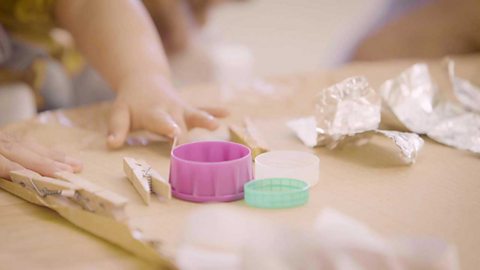
Feely bag inspiration
Put a few different things in a bag or empty pillowcase. For young children, this could be everyday objects (a hairbrush, a spoon, some sunglasses⊠) or you could use less familiar items for older children, such as different fruit or vegetables. Get your child to close their eyes, and find one object in the bag. Describe it together, using all the senses, then paint, draw, or make a version of it using plasticine. If your child paints or draws the object, you could then make the pictures into flashcards.
Imaginative arty play
Think about how you can get your childâs toys involved in some creative activity. Some children wonât want to touch the paint or craft resources themselves, but toy cars can drive through paint, and toy animals can jump onto playdough and leave footprints. If your child is just learning to use action words like 'jump' or 'walk', you can repeat these lots. If your child is talking in short sentences then match your language to theirs by using sentences too, such as âmy car is drivingâ or âthe elephant is marchingâ.
Your recycling bin can also be a source of craft materials. An empty cardboard box can become a house or a garage for toys, or a rocket or boat for your child. Cardboard tubes can even become binoculars. Once youâve made the toy together, itâs time to play. Imaginative play is the beginning of storytelling, and the stories you create together will boost their language skills.
Important safety advice
Keep an eye on your child at all times during craft activities and playtime. And remember to keep small and sharp objects out of their reach.

